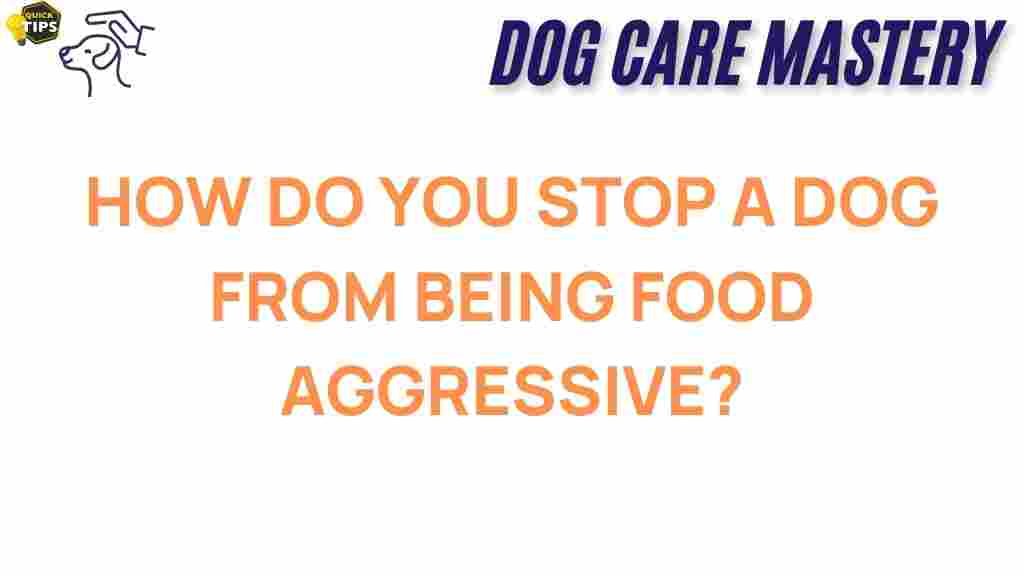Unraveling the Secrets of Food Aggression in Dogs
Food aggression in dogs is a behavioral issue that many pet owners face. This phenomenon can manifest in various forms, from growling and snapping to outright biting when a dog feels threatened during mealtime. Understanding the roots of food aggression, its triggers, and how to address it is essential for creating a safe and harmonious environment for both pets and their owners. In this article, we will explore the causes of food aggression, practical solutions to mitigate it, and tips for ensuring a peaceful dining experience for your furry friend.
Understanding Food Aggression
Food aggression is not simply a behavioral flaw; it often stems from a dog’s instincts and past experiences. Here are some key aspects to consider:
- Instinctual Behavior: Dogs are pack animals, and in the wild, food is a valuable resource. Protecting it from others is a natural instinct.
- Early Life Experiences: Dogs that were not adequately socialized or faced food scarcity may develop aggressive behaviors to protect their food.
- Territoriality: Some dogs feel possessive over their food, leading them to react aggressively to perceived threats.
Identifying Food Aggression
Recognizing the signs of food aggression is crucial for addressing the problem effectively. Common behaviors include:
- Growling: A clear warning that your dog is feeling threatened.
- Snapping or Biting: More severe responses that can lead to injury.
- Stiff Body Posture: A sign that your dog is tense and feels protective over its food.
- Food Hoarding: Taking food away to a safe space can indicate food aggression.
Steps to Mitigate Food Aggression
Addressing food aggression requires patience, consistency, and a strategic approach. Follow these steps to help your dog overcome this behavior:
1. Assess the Situation
Before taking action, assess the severity of the food aggression. Observe your dog’s behavior during feeding time and identify triggers. Consider the following:
- Is the aggression directed towards humans, other pets, or both?
- What specific situations lead to aggressive behavior?
2. Create a Safe Feeding Environment
Establish a calm and secure space for your dog to eat. Here are some tips:
- Choose a quiet spot away from distractions.
- Use a designated feeding area to create boundaries.
- Ensure that other pets are not in proximity during mealtime.
3. Implement Gradual Desensitization
Desensitization involves gradually exposing your dog to situations that trigger aggression without causing anxiety. Here’s how to do it:
- Start by standing at a distance while your dog eats.
- Slowly decrease the distance over several feeding sessions.
- Introduce treats or toys while your dog eats to create positive associations.
4. Use Positive Reinforcement
Reward your dog for calm behavior during feeding times. Consider these approaches:
- Give treats when your dog allows you to approach its food bowl.
- Use praise or toys as rewards for non-aggressive behavior.
- Practice “leave it” commands to reinforce control over food.
5. Feed Separately
If you have multiple pets, consider feeding them in separate rooms or at different times to reduce competition for food. This can significantly help in reducing food aggression.
6. Consult a Professional
If the aggression persists despite your efforts, consider seeking help from a professional dog trainer or behaviorist. They can provide tailored strategies to address food aggression effectively.
Troubleshooting Common Issues
While working to reduce food aggression, you may encounter challenges. Here are some troubleshooting tips:
1. Inconsistent Feeding Schedule
Dogs thrive on routine. Ensure you’re feeding your dog at the same time every day to establish predictability.
2. Poor Diet
A balanced diet contributes to a dog’s overall well-being. Consult your veterinarian to ensure your dog receives the proper nutrients, which can help reduce anxiety and aggression.
3. Lack of Exercise
Regular exercise can alleviate pent-up energy, reducing stress and aggression. Incorporate daily walks, playtime, and mental stimulation into your dog’s routine.
4. Stressful Environment
A chaotic household can heighten anxiety in dogs. Create a calm environment by minimizing loud noises and establishing a routine.
Conclusion
Food aggression in dogs is a serious issue but can be effectively managed with the right approach. By understanding the causes and implementing the steps outlined in this article, you can help your dog learn to feel secure around food. Remember that patience and consistency are key. If the problem persists, don’t hesitate to reach out to a professional. For more on dog training techniques, check out our dog training resources. For additional information on canine behavior, visit the American Kennel Club website.
With time and dedication, you can create a peaceful dining experience for your dog, ensuring that both of you can enjoy mealtime without fear or aggression.
This article is in the category Behavior and created by dogcaremastery Team

1 thought on “Unraveling the Secrets of Food Aggression in Dogs”